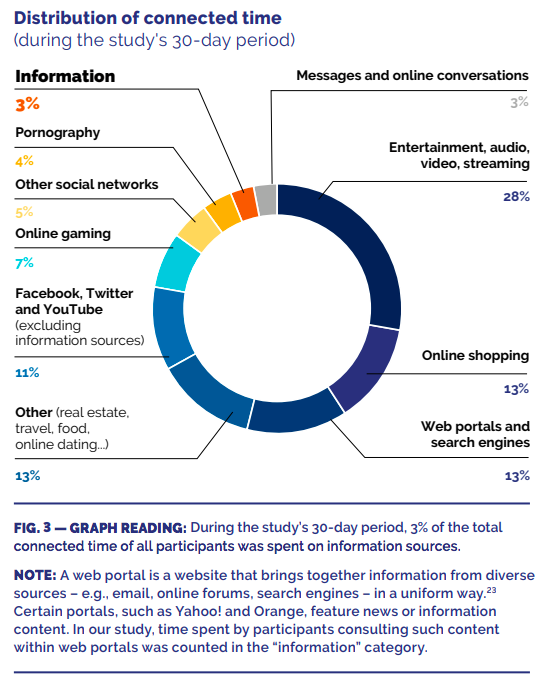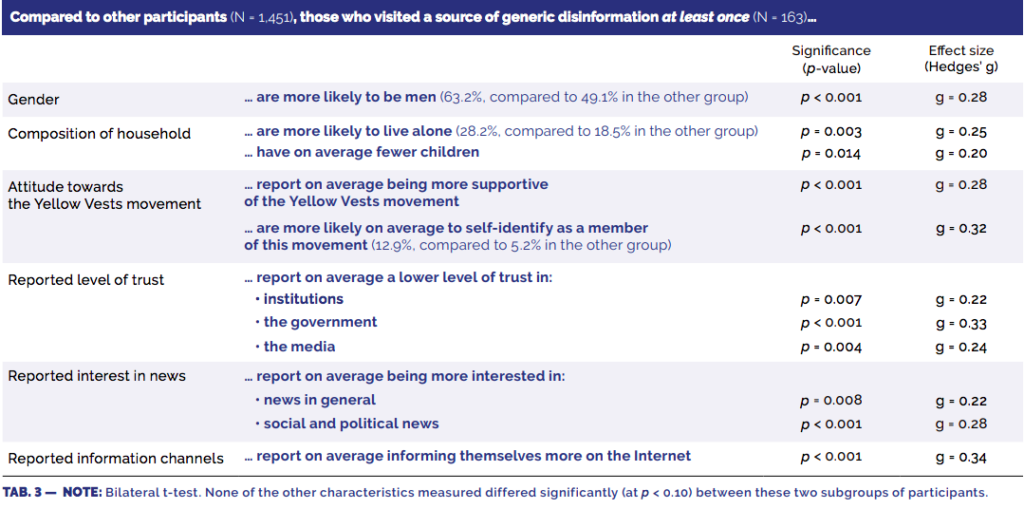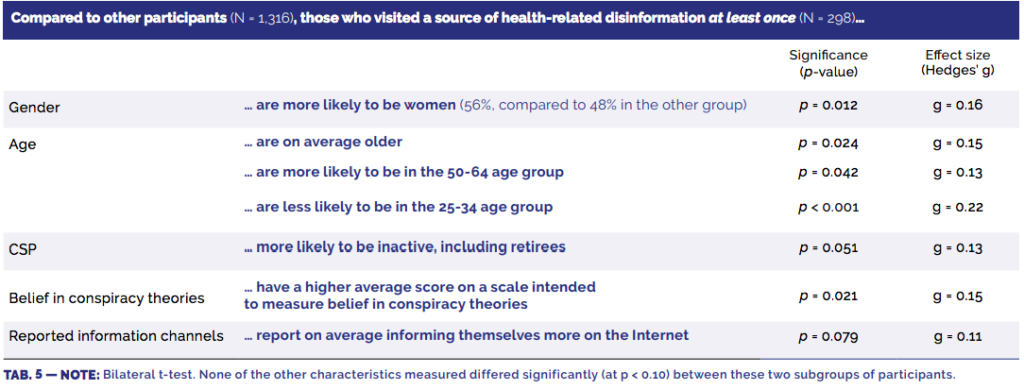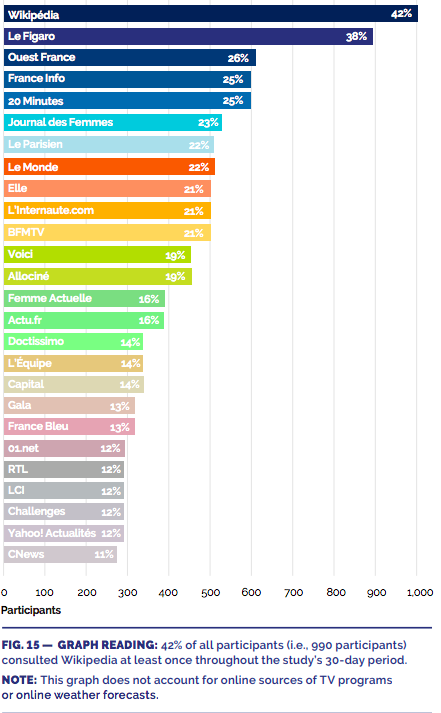
An article by Laurent Cordonier published in The Conversation
The Covid health crisis has been surrounded by a litany of rumors, fake news and other conspiracy theories that have been widely disseminated, particularly on social networks. Far from being innocent, this fake news has led some individuals in France to doubt the effectiveness or safety of vaccines, or even the very existence of the pandemic. While the Internet can function as an echo chamber for false information, whatever the subject, its development has also allowed easy and rapid access to reliable news information. What do we know about how the French use this abundant supply of information?
Survey-based studies, such as that conducted annually by the Reuters Institute in several dozen countries, including France, allow us to identify the media outlets that our fellow citizens report consulting the most online and to understand the way in which they reportedly use the Internet for news information. But this methodology does not allow us to evaluate whether respondents’ statements correspond to their effective information behavior. Conversely, studies that measure the overall volume of traffic on media websites do not enable much more than the ranking of the most popular websites in a given region for a given time period.
With the Fondation Descartes, we have conducted study with an innovative methodology in order to describe in greater detail the information behavior of the French on the Internet.
How the French inform themselves on the Internet
To carry out this study, we asked Respondi, a company specializing in digital data, to record for 30 consecutive days the entire Internet activity of a panel of individuals representative of the French population. The connection data of the 2,372 participants constituting this panel was recorded, URL by URL, on their various personal connected devices (computers, smartphones, tablets). We were then able to analyze their consultation of 2,946 online news sources previously identified via a website classification algorithm designed by the company Storyzy. These sources include the web pages of national, regional, and local print media, of TV and radio stations featuring news content, of news aggregators such as MSN News, and of “alternative” media regularly accused of publishing false information. Following the 30 days of the study, we sent participants a survey in order to establish their sociological profile and to inquire about their relationship to news information.
It should be noted that we did not have access to participants’ social media “feeds” or “walls”. But this does not mean that our analyses ignore their exposure to news information via social networks. Indeed, we recorded the time spent by participants on the Facebook, Twitter, and YouTube pages of the news sources identified. In addition, participants who clicked on an article or a video featured on their personal “feed” or “wall” will generally have been redirected to the web page hosting the content in question, where the time spent by participants was recorded.
Internet behind TV
The results of our study show that, as a whole, the French inform themselves little on the Internet: on average, only 3% of participants’ total connected time was spent on news sources – which, per participants, corresponds to less than 5 minutes per day they connected to the Internet. In comparison, for French individuals aged 15 and over, the average daily listening time of major TV newscasts via television is 20 minutes.

Distribution of time connected to the Internet..
L. Cordonier, A. Brest/Fondation Descartes
It should be noted that the online information behaviors of the French that we measured are, in truth, very diverse. While 17% of participants consulted no news sources on the Internet over 30 days, 5% spent a total of over ten hours consulting such sources over the same time period. We observe that individuals aged 50 and over, as well as those who declare being particularly interested in the news, inform themselves more on the Internet than others.
The website classification algorithm used also enabled us to evaluate participants’ exposure to disinformation. Our analyses show that 39% consulted an online source known to disseminate false or misleading information during the study’s 30-day period. These participants spent on average 11% of their daily connected time dedicated to news consumption on these sources, which corresponds to 0.4% of their total connected time.
Compared to other participants, those who consulted at least once a website disseminating unreliable information on social and political topics are proportionately more likely to be men, to live alone, to distrust institutions, the government, and the media, and to declare being interested in the news.

Characteristics of participants who consulted at least once a source of social and political disinformation.
The profile of participants who consulted at least once a source of disinformation on health-related issues is different. Compared to other participants, we find among them more women, more elderly individuals, and more inactive individuals, including retirees. This last group is also proportionately more likely to fall prey to “click-bait” websites, which disseminate misleading information for the sole purpose of driving traffic to their pages.

Characteristics of participants who consulted at least once a source of health-related disinformation.
Browsing
Our study reveals a “browsing” behavior among consumers of news information on the Internet, who seem to switch from one news source to the next often without consulting any one source for a significant amount of time. This is evidenced by the fact that the average time spent on a news source per consultation is less than 2 minutes. Although this average time varies significantly among participants, it exceeds 4 minutes for only 6% of participants,
When we examine the online news sources most consulted by participants, we find that the top 26 sources alone account for 40% of the time they dedicated to informing themselves on the Internet. This “top 26” is largely composed of the online sources of traditional media, with Wikipedia as a notable exception. Major traditional media outlets have therefore succeeded in exploiting their offline reputation to assert themselves as major players in the online information market.

Top 26 news sources most consulted on the Internet.
A fuzzy perception of our own information behavior
In the end-of-study survey sent to participants, we asked to them indicate the frequency with which they had consulted a selection of 15 of the most visited news sources in France on the Internet during the previous 30 days. For each of these sources, participants could indicate that they had “never” consulted it during this period, or that they had done so “at least once during the 30 days”, “at least once a week”, or “more or less every day”.
In order to know if the French are generally aware of the online sources they consult for information, we compared the answers of the 1,536 participants who completed the survey with their effective consultation of these 15 news sources. Our analyses show that, overall, the fact of reporting exposure to a news source “more or less every day” rather than “never” is associated with a significant increase in the probability of having effectively consulted it at least once during the 30-day study period.
However, participants seem to have a relatively fuzzy perception of their online information behavior. Indeed, in their statements, they tended to greatly overestimate their effective consultation of the news sources selected. As such, overall, participants who declared consulting these sources “more or less every day” during the 30 days of the study only had a 36% chance of having done so even once during this period – a probability which varies significantly from one news source to another. Conversely, a sizable proportion of participants who declared “never” consulting a given news source over the 30 days in fact did so at least once.
No matter the source?
How can we explain such a discrepancy between the news sources individuals declare consulting and those that they effectively consult? While our study’s data do not allow us to directly answer this question, we can nevertheless suggest that it is difficult for anyone to precisely describe their informational itinerary on the Internet. This would require a significant effort of attention and memorization without any real interest for individuals.
More generally, given the short time spent on average on a single news source per consultation, it seems that many Internet users are satisfied with a fairly minimal amount of news information on the web. A study published in 2016 showed that the majority of articles shared by Internet users on Twitter are shared without having been read. It is therefore on the basis of their title alone that users deemed these articles interesting and worthy of being shared with the people who follow them on social networks.
In this context, Internet users may not be overly concerned with the sources of the articles they browse online. The problem with such a lack of vigilance regarding the origin of news encountered on the Internet is that it benefits disinformation, helping it to infiltrate thoughts and to be relayed on the web by individuals who are themselves victims of this disinformation.
Aurélien Brest (Fondation Descartes) contributed to this article.
Laurent Cordonier, Sociologist – PhD in social sciences, Université de Paris
This article is republished from The Conversation under a Creative Commons license. Read the original article.
